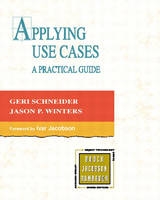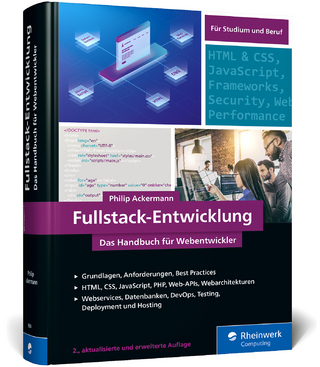
Applying Use Cases
Addison Wesley (Verlag)
978-0-201-30981-2 (ISBN)
- Titel erscheint in neuer Auflage
- Artikel merken
Many projects struggle to define the specific functions of software, and end users often find that the final product does not perform as expected. Use cases allow analysts to identify the required features of a software system based on how each end user will use the system. This efficient and straightforward analysis process gives end users direct input into the design of the system that will serve them. Applying Use Cases provides a practical and clear introduction to developing use cases, demonstrating their use via a continuing case study. Using the Unified Software Development Process as a framework and the Unified Modeling Language (UML) as a notation, the authors step the reader through applying use cases in the different phases of the process, focusing on where and how use cases are best applied.Other highlights include: *A collection of realistic examples showing how to apply use cases, drawn from the authors' extensive experience in this area *A case study that offers insight into the common mistakes and pitfalls that can plague an object-oriented project *An illustration of the latest version of the UML notation for diagramming use cases *A practical "how-to" discussion on applying use cases to identify system requirements 0201309815B04062001
Geri Schneider is a senior consultant and trainer at Andrews Technology, Inc., in the areas of iterative development, software project management, object-oriented analysis and design, software architecture, design patterns, and use cases. In addition, she teaches in the software engineering management certificate program for the University of California Santa Cruz Extension. She previously worked for Rational Software Corporation mentoring customers in the areas of iterative development, object technologies, and use case analysis. Jason P. Winters is a staff design engineer for Cadence Design Systems, Inc. He was previously with Lucent Technologies as a staff engineer. At Lucent, he designed and built specialized tools, promoted the use of modern software development practices and tools throughout the company, and mentored projects on object-oriented analysis and design, UML, and use cases. 0201309815AB04062001
(All chapters, except 7 and 9, conclude with a Chapter Review.)
Foreword.
Preface.
Acknowledgments.
1. Getting Started.
An Iterative Software Process.
An Example Project.
The Project Description.
Starting Risk Analysis.
2. Identifying System Boundaries.
Identifying Actors.
Identifying Use Cases.
Describing Actors and Use Cases.
Handling Time.
Potential Boundary Problems.
Scoping the Project.
3. Primary Scenarios.
The Complete Use Case.
Handling Complex Use Cases.
Scenarios.
The Primary Scenario.
Guidelines for Correctness and Completeness.
Other Requirements.
Presentation Styles.
4. Secondary Scenarios.
Finding Secondary Scenarios.
Detailing Significant Behavior.
Use Case Description Revisited.
5. Diagramming Use Cases.
Activity Diagrams.
Diagramming the User Interface.
6. Dividing Large Systems.
Architectural Patterns.
Testing the Architecture with Use Cases.
Defining Interfaces Between Subsystems.
Allocating Use Cases to Subsystems.
Creating Subsystem Documentation.
7. Documenting Use Cases.
Documentation Templates.
Order-Processing System Use Cases.
Order Processing System.
System Level Use Cases.
8. Use Cases and the Project Plan.
Planning the Project.
Estimating Work with Use Cases.
9. Reviews.
Review for Completeness.
Review for Potential Problems.
Review with End Users.
Review with Customers.
Review with Development.
Reviewers.
Adding Flexibility to Your System.
10. Constructing and Delivering a System.
Key Abstractions of the Domain.
The Iteration Schedule.
Delivery and Beyond.
Final Wrap-Up.
Appendix A. Resource List.
Appendix B. Documentation Templates.
System or Subsystem Documents.
Use Case Document.
Scenario Document.
Appendix C. UML Notation Used in This Book.
Appendix D. Reply Form for the Use Case Estimator.
Index.
| Erscheint lt. Verlag | 18.9.1998 |
|---|---|
| Verlagsort | Boston |
| Sprache | englisch |
| Maße | 186 x 233 mm |
| Gewicht | 320 g |
| Themenwelt | Mathematik / Informatik ► Informatik ► Programmiersprachen / -werkzeuge |
| Mathematik / Informatik ► Informatik ► Software Entwicklung | |
| Mathematik / Informatik ► Informatik ► Theorie / Studium | |
| ISBN-10 | 0-201-30981-5 / 0201309815 |
| ISBN-13 | 978-0-201-30981-2 / 9780201309812 |
| Zustand | Neuware |
| Haben Sie eine Frage zum Produkt? |
aus dem Bereich



